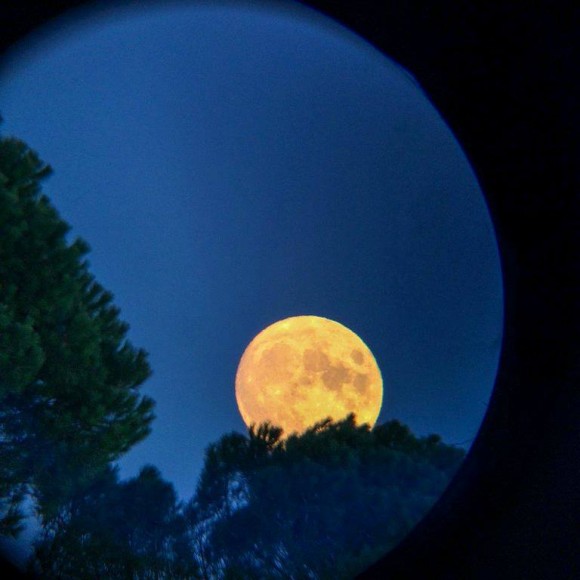
Full moonrise, above, by Mohamed Laaifat Photographies in Normandy, France.
Tonight – January 11, 2017 – the moon will appear bright and full in the sky from around the world. It’ll look full tomorrow night, too, because, in fact, the moon appears full for a couple of nights around its fullest phase. That exact fullest moon falls on January 12 at 11:34 UTC. For the mainland United States, the moon reaches the crest of its full phase before sunrise January 12: 6:34 a.m. EST, 5:34 a.m. CST, 4:34 a.m. MST or 3:34 a.m. PST.
Thus if you’re in the Americas, your fullest moon falls during the night of January 11, or, more precisely, in the hours before dawn January 12. If you’re in Asia, the moon is fullest for you on the night of January 12. If you’re in between, pick one or both for moon-watching. Either night will do!
The January 2017 full moon counts as the first full moon after the December solstice. In North America, we often this full moon the Wolf Moon, Old Moon or Moon After Yule.
Donate: Your support means the world to us

What is this crest of the moon’s full phase? Astronomically speaking, the moon is full at the moment that it’s most opposite the sun in its orbit (180o from the sun in celestial or ecliptic longitude). That’s what the time of the full moon means. But of course the moon at the vicinity of full moon shines all night long, from dusk to dawn, as seen from around the globe.
Want to know when this January 2017 moon reaches the crest of its full phase as seen from around the world? Look at the worldwide map below. You can see that the full moon comes near the midnight hour at the International Date Line, close to noon at the prime meridian of 0o longitude, shortly before sunrise on January 12 at the Eastern Seaboard of the United States and at sunset January 12 in Asia.
To see the moon at the instant of full moon, the moon has to be above your horizon on the nighttime side of the world.
But again – even if it’s not full moon crest for you – all of us will see a full-looking moon lighting up the sky tonight and tomorrow, more or less all night.

In both the Northern and Southern Hemispheres, the January sun – unlike the January full moon – rises south of due east and sets south of due west. In the Northern Hemisphere, these far-southern risings and settings of the sun give us the short days of winter.
South of the equator, the same far-southern sunrises and sunsets bring long summer days.
Meanwhile, the full moon lies opposite the sun, mirroring the sun’s place in front of the backdrop stars for six months hence.
And that’s why tonight’s moon – like the sun in summer – will follow a high path across the sky as seen from the northern part of the globe – and a low path as seen from the southern. This January full moon rises north of due east around sunset, climbs highest in the sky around midnight and sets north of due west around sunrise.
Bottom line: Full moon is January 12, 2017 at 11:34 UTC. Fullest moon for you on the night of January 11 if you’re in the Americas, and on January 12 if you’re in Asia. In between? Either night will do!











